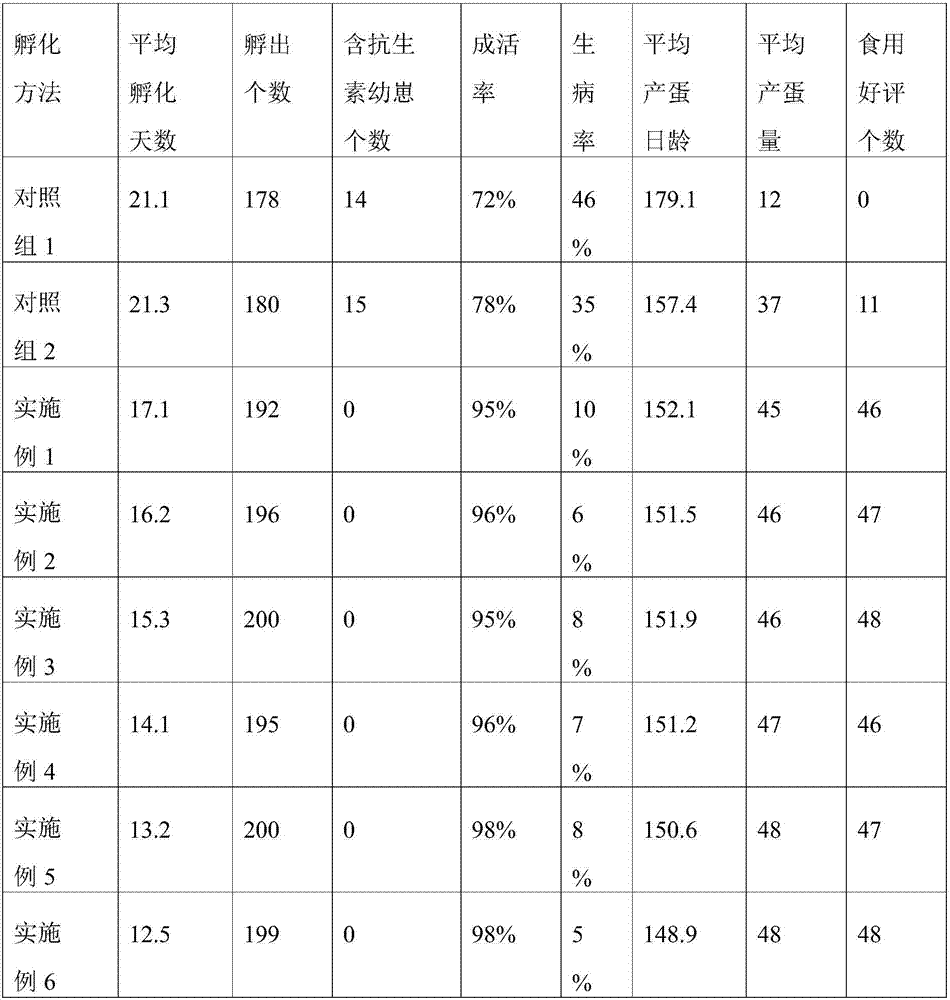Breeding method for laying hen
A breeding method and laying hen technology, applied in the field of laying hen breeding, can solve the problems of short supply, low yield, difficulty in providing native chickens and native eggs without antibiotics and hormones, etc.
- Summary
- Abstract
- Description
- Claims
- Application Information
AI Technical Summary
Problems solved by technology
Method used
Image
Examples
Embodiment 1
[0026] A breeding method for laying hens, comprising:
[0027] Step 1. Wash the eggs with rice-washing water and put them in the sun to dry for 45 minutes, then put them in a cool place for later use;
[0028] Step 2, bury the spare eggs in the mixture of bamboo charcoal powder, tourmaline powder, bamboo vinegar, wood bran and water for 25 hours, and control the temperature at 41°C;
[0029] Step 3. Take out the eggs and place them on the incubation tray. From the first day to the third day of incubation, control the temperature of the hatching space to 40°C and the humidity to 66%. From the fourth day to the seventh day of incubation, control the temperature of the hatching space to 40°C. ℃, humidity is 73%, from the 8th day of incubation to when the chicks are hatched, the temperature of the hatching space is controlled at 39°C, and the humidity is 77%, and the daily sunshine time is 8 :00 to 9:00;
[0030] Step 4. Feed the hatched 1-5 day-old chicks with a mixture of vege...
Embodiment 2
[0035] A breeding method for laying hens, comprising:
[0036] Step 1. Wash the eggs with rice-washing water, put them in the sun for 30 minutes, and put them in a cool place for later use;
[0037] Step 2, bury the spare eggs in the mixture of bamboo charcoal powder, tourmaline powder, bamboo vinegar, wood bran and water for 24 hours, and control the temperature at 42°C;
[0038] Step 3. Take out the eggs and place them on the incubation tray. From the first day to the third day of incubation, control the temperature of the incubation space to 40.5°C and the humidity to 70%. From the fourth day to the seventh day of incubation, control the temperature of the incubation space to 40°C. ℃, humidity is 75%, from the 8th day of incubation to when the chicks are hatched, the temperature of the hatching space is controlled at 39°C, and the humidity is 77%, and the daily sunshine time is 8 :00 to 9:00;
[0039] Step 4. Feed the hatched 1-5 day-old chicks with a mixture of vegetable s...
Embodiment 3
[0044] A breeding method for laying hens, comprising:
[0045] Step 1. Wash the eggs with rice-washing water, put them in the sun for 30 minutes, and put them in a cool place for later use;
[0046] Step 2. Bury the spare eggs in the mixture of bamboo charcoal powder, tourmaline powder, bamboo vinegar, wood bran and water for 24 hours, and control the temperature at 41°C. Bamboo charcoal powder, tourmaline powder, bamboo vinegar, wood bran and water The mass ratio is 2:3:1:50:15. ;
[0047] Step 3. Take out the eggs and place them on the hatching tray. The oxygen content in the hatching space is kept at 2%. From the first day to the third day of incubation, the temperature of the hatching space is controlled at 40°C and the humidity is 65%. The temperature of the hatching space is controlled at 39°C and the humidity is 70% for 7 days. From the 8th day of incubation to the time when the chicks hatch, the temperature of the hatching space is controlled at 38.6°C and the humidi...
PUM
 Login to View More
Login to View More Abstract
Description
Claims
Application Information
 Login to View More
Login to View More - R&D
- Intellectual Property
- Life Sciences
- Materials
- Tech Scout
- Unparalleled Data Quality
- Higher Quality Content
- 60% Fewer Hallucinations
Browse by: Latest US Patents, China's latest patents, Technical Efficacy Thesaurus, Application Domain, Technology Topic, Popular Technical Reports.
© 2025 PatSnap. All rights reserved.Legal|Privacy policy|Modern Slavery Act Transparency Statement|Sitemap|About US| Contact US: help@patsnap.com

